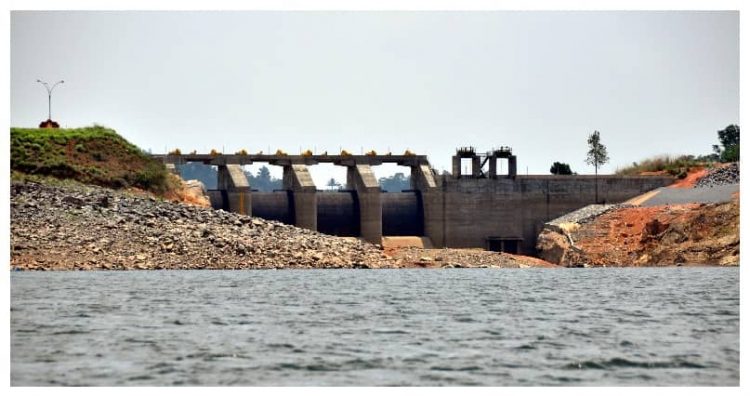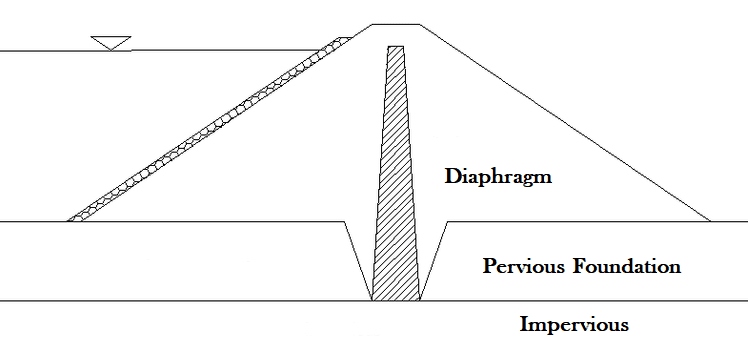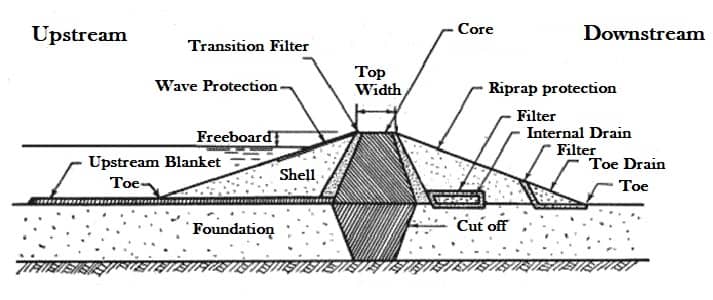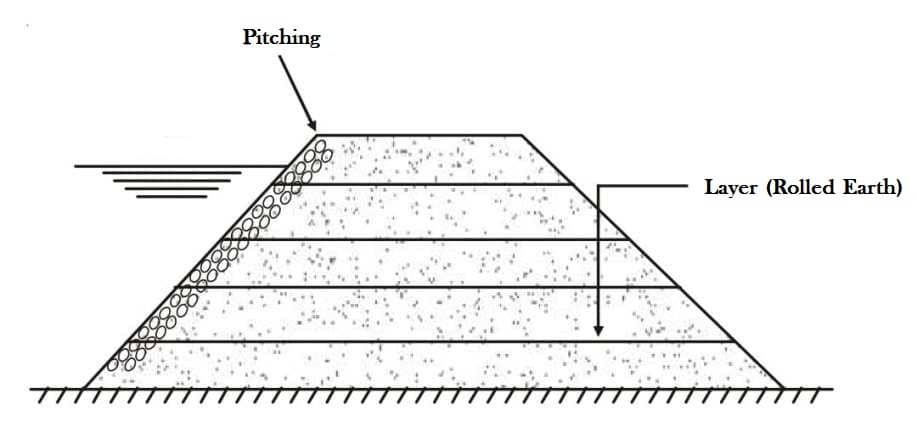Earthen Dam
Earthen dam is a type of dam which is built by the successive layers of the earth at the bank of the river where the soil and materials get deposited. A gate is constructed in the dam to control the flow of the river.
The embankment is constructed by homogeneous material. It is also known as an embankment dam. The dam is constructed by earthen materials like silt, gravel, stone, and clay. That’s why it is known as the earthen dam.
There are some situations as follows that’s needed to construct the earthen dam:
- In an area where large construction is not possible then the earthen dam is constructed.
- If the flow of the river is continuous throughout the year then the dam is constructed to control the flow of the river.
- If there is plenty of earthen material available nearby the local area then dam construction is most economical and suitable.
- If the foundation is not sufficiently strong then an earthen dam is constructed.
- If the funding given by the government is low.
Types of Earthen Dam
There are three types of earthen dams are as follows:
- Homogeneous earthen dam
- Diaphragm earthen dam
- Zoned earthen dam
1. Homogeneous Earthen Dam
The earthen dam which is constructed by only one material or by the same material is used to construct the whole structure then it is called the homogeneous earthen dam. If plenty of only one type of earthen material is available in the local area the dam construction is most economical.

The homogeneous earthen dam is used for low or medium-high dams. Due to purely one type of material used in the dam creates a major problem of seepage So this needs to be constructed in layered form so this makes the dam stable and the entire structure safe against piping.
2. Diaphragm Earthen Dam
This dam is better than the homogeneous dam because it has an impermeable layer that prevents seepage and this layer is covered by earth and rock.

The impermeable layer is known as the diaphragm of the dam, that’s why it is called the diaphragm earthen dam. The impermeable layer is constructed of wood, rock, stone, steel, and concrete.
The diaphragm is strong enough to prevent the dam from seepage and it is located at the center of the dam section.
3. Zoned Earthen Dam
It is just a modification of both the previous dam. This dam has the property to identify or check the seepage. The impermeable core (which is surrounded by the transition zone) is at the center of the dam.

This transition is provided to avoid the crack on the piping and installed at the central part of the dam. The outer zone is also strong enough to protect the central impermeable filler l part of the dam and distribute the load to the large area of the foundation.
Also Read: Complete Information on Sardar Sarovar Dam
Components of the Earthen Dams

Hearting(core): It is the central part of the dam constructed by the clayey soil. The soil is compacted to tighten the soil and provide shear strength to the dam against slipping.
Casing: The core is surrounded by a layer and this layer is known as casing, constructed by soft rock or sand and gravel. It prevents it from cracking, slipping and provides stability to the core layer.
Rock toe: Rock toe is constructed of small stone or rock pieces whose size is larger than 20cm. Rock toe provides stability to the dam and prevents it from seepage.
Pitching: Stone of size 30cm can be used for layering (thickness 30cm -45cm). This layer is known as pitching in dams and it prevents sudden drawdown and provides stability.
Turfing: Turfing is a process of planting a special type of grass called doob or turfing grass on the downstream face of the dam. It prevents water logging due to heavy rainfall.
Berms: Berms are the offset provided on the downstream at 8m to 10m of the interval of width 3m to 5m. It is used to collect the rainwater and dispose of it safely. It is constructed to provide roadways for the vehicle, to reduce the flow of rainwater.
Drain: A series of drains is constructed containing different types of drains that are longitudinal drains, cross drains and toe drains on the downstream side of the dam.
Transition filters: It is a filter provided in between the clayey soil layer and sandy shell to avoid pore pressure.
Advantages of Earthen dam
- It can simply be constructed with locally available material.
- The design of the dam is also quite easy so a variety of materials can be used to construct the dam.
- It is most economical because it is constructed with locally available materials.
- Any type of foundation is suitable for this dam.
- Where there is a wide layer of the valley it is suitable to construct.
Disadvantages of Earthen dam
- It causes a lot of leakage and soil erosion.
- Due to improper capacity, it may fail.
Difference between Gravity dam and Earthen dam
|
Earthen dam |
Gravity dam |
| It has more seepage problem | It has less seepage problem |
| It can be suitable for any type of foundation. | It can be constructed with only a foundation made up of stone or rock. |
| Most economical | Less costly |
| It is constructed with locally available materials like clay, stone. | It is constructed by only stone rock and concrete. |
Method of Constructing a dam
There are two methods of construction earthen dam as follows:
1. Hydraulic fill method
In this method of construction, first of all, excavation of soil is done then the soil is transported by the water to construct the dam structure. Pipes are laid along the outer face of the embankment. All the soil materials are mixed with the water then poured into the pipes.

All the necessary steps are done by the hydraulic method. No compaction is done by a roller as the soil gets deposited by the hydraulic operation.
2. Rolled fill method
In this method of construction, a machine is used for excavation of soil, placing a layer of thickness 20cm and compacting at optimum moisture content.

This is a very popular method for constructing the earthen dam. The soil is brought to the site from the pit by the bulldozer and compacted by the roller.
Causes of Failure of the Earthen dam
The causes of failure are as follows:
1. Structural failure
- Failure by the burrowing animal because it causes damage.
- Failure by spreading of waterlogging.
- Slope failure by the seepage water.
- Landslide due to instability of the soil particles.
- Foundation slides by the reduction of the strength by the continuous flow of seepage water.
- A sudden drawdown may cause upstream slope failure.
- Pore pressure may cause upstream/ download slope failure.
2. Hydraulic failure
- overtopping of the dam height due to the overflow of the river and if the capability spillway is not sufficient.
- Due to wave erosion, the soil gets loose or gets removed from the upstream face of the dam.
- Toe erosion: erosion takes place due to the storage of water of tail water
- Gullying: construction of gully in the earthen dam causes heavy downpour and it can be prevented by providing a berm or good drainage system.
3. Seepage failure
- Piping: The flow of the water from the foundation can make the soil loose and reduce the strength of the foundation and cause erosion of leaks and lead to a large number of catastrophic failures.
- Sloughing: Failure caused by the sloughing is slightly similar to the piping. The downstream is saturated and it may erode, produce a small slump, or slide in the condition of the full reservoir.
Video on Earthen Dam
Also Read: Prevention of Slope Failure


Leave a comment